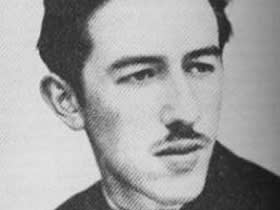Gil Joseph Wolman, L'Anticoncept
Introduced by Kaira M. Cabañas
Friday, February 13th, 2015 at 7:30 pm
Light Industry
155 Freeman Street
Brooklyn, New York
L'Anticoncept, Gil Joseph Wolman, 1951, digital projection, 60 mins
Projected on a helium-inflated spherical weather balloon approximately two meters in diameter, L'Anticoncept is a sound film without images: it alternates between brief black sequences and a white disk whose edge in projection matches as close as possible the screen's circumference. Gil Joseph Wolman achieved L'Anticoncept in September 1951, and it was first shown on February 11th, 1952, at the Ciné-Club Avant-Garde 52 at the Musée de l'Homme in Paris. While other Lettrists such as Isidore Isou and Maurice Lemaître waged an attack on conventional spectatorship through markedly dissociative strategies (e.g., the disjunctures between speech and sound, sound and image, and between screen and space deployed in their films), Wolman went further by totally abandoning the photographic image and altering the shape of the screen.
In 1952 L'anticoncept's critical reception was as scant as it was varied. One critic took issue with Wolman's use of the term images to refer to what he calls "simple spasmodic spurts of white light on a sphere". Another, a writer for Le Figaro magazine, explained, "you suppress the image and you keep the sound and what sound!...sneers, strangulations, gurgles, onomatopoeia".
L'anticoncept's soundtrack begins with a voiceover that invokes the history of moving images. Part two presents TRITS, a Lettrist poem structured around a chorus and punctuated by the whistling, phonemes, and other sounds pronounced from four superimposed voices, seemingly all Wolman's. In part three, the longest part of the sound track, Wolman reads a disjointed story that he authored. Here the voiceover's incessant speech contributes in a large measure to the experience of an aural assault. The soundtrack provides little respite (that is, few silences) from its verbal bursts and abrupt shifts in volume and pace. Finally, after a short "Post-scriptum", the film ends with approximately three minutes and thirty seconds of superimposed mégapneumie, what Wolman elsewhere described as a poésie physique that is based on breath, rather than on the letter as with Isou, and that explored the use of "all human sounds".
A year after the original screening, Guy Debord observed that L'Anticoncept was "more offensive...than the images of Eisenstein, which frightened Europe for so long." ? KMC
The year 2015 marks 20 years since Gil Joseph Wolman's death. We are grateful to Barbara Wolman, Hedy Laure Wolman, and Frédéric Acquaviva for making this screening possible; the last showing of L'Anticoncept in New York took place in 1999, in the context of the exhibition Global Conceptualism: Points of Origin 1950s-1980s at the Queens Museum of Art. Tonight's event also marks the publication of Cabañas's new book Off-Screen Cinema: Isidore Isou and the Lettrist Avant-Garde (University of Chicago), copies of which will be available at Light Industry.
Kaira M. Cabañas is an art historian and visiting professor in the Departamento de Letras at the Pontifical Catholic University of Rio de Janeiro, as well as the author of The Myth of Nouveau Réalisme: Art and the Performative in Postwar France (Yale University Press, 2013). In 2012 she served as co-curator for the exhibition Specters of Artaud: Language and the Arts in the 1950s at the Museo Nacional Centro de Arte Reina Sofía. Cabañas's writings have appeared in numerous museum catalogs and academic journals. She regularly contributes to Artforum.
Tickets - $7, available at door.
Please note: seating is limited. First-come, first-served.
Box office opens at 7pm.


